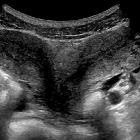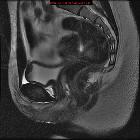müllerian duct anomalies





























Müllerian duct anomalies (MDAs) are congenital abnormalities that occur when the Müllerian ducts (paramesonephric ducts) do not develop correctly. This may be as a result of complete agenesis, defective vertical or lateral fusion, or resorption failure.
Epidemiology
MDAs are estimated to occur in 1-5% of all women. There is a higher rate of women with repeated miscarriages (3-15%) .
Clinical presentation
Despite these anomalies being common , the majority are asymptomatic. Obstruction of the Müllerian duct may occur, and patients present with an abdominal mass and dysmenorrhea. Delayed treatment may result in severe consequences and potentially infertility. Patients may also present with recurrent miscarriages and infertility .
Pathology
Subtypes
The Müllerian duct anomaly classification system divides them according to clinical manifestations, prognosis, and treatment. Accurate diagnosis is essential since management varies according to the type of malformation.
- uterine agenesis: ~10%
- arcuate uterus: often considered as part of normal anatomical variation, ~7%
- unicornuate uterus: ~15% (range 5-25%)
- uterine duplication anomalies
- uterus didelphys: ~7.5 % (range 5-11%)
- bicornuate uterus: ~25% (range 10-39%)
- septate uterus: ~45% (range 34-55%)
Associations
Renal anomalies are frequently associated, most commonly renal agenesis but also crossed fused renal ectopia, and duplex kidney .
Radiographic features
Ultrasound
- should be performed initially
- confirms any structural abnormalities of the genital tract
- sometimes cannot help to identify the type of MDA (especially on 2D imaging alone)
- 3D coronal transvaginal imaging has a high degree of diagnostic accuracy and ideally should be performed in the secretory phase of the menstrual cycle
MRI
- valuable noninvasive technique
- evaluation of the female pelvic anatomy
- accurate MDA classification
Treatment and prognosis
Many patients are asymptomatic and require no treatment. However, where obstruction occurs, surgical intervention is usually required and may result in permanent infertility - counseling is required.
See also
Siehe auch:
- Uterus
- Uterus didelphys
- Müllerian duct anomaly classification
- Uterus arcuatus
- Uterus septus
- Uterus bicornis
- Mayer-Rokitansky-Küster-Hauser syndrome
- Uterus unicornis
- Müller-Gang
- transverses Vaginalseptum
- obstruierte Hemivagina und ipsilaterale renale Anomalie (OHVIRA) Syndrom
- Vaginalseptum
- Duplikatur des Uterus
- Uterusagenesie
- Müller-Gang-Persistenzsyndrom
- class IV Mullerian duct anomaly
und weiter:
- Hysterosalpingographie
- Vagina
- cervical incompetence
- velamentous cord insertion
- MRKHS
- fetal akinesia / hypokinesia sequence
- Entwicklungsanomalien der Plazenta
- Müller Gang Embryologie
- infertility in the exam
- haematometrocolpos
- MRKH
- Anomalien des urogenitalen Systems
- gynäkologisch radiologisches Curriculum
- longitudinales Vaginalseptum
- primary amenhorrea due to Müllerian duct anomalies
- mullerian duct cyst in an infant
- hydrometrocolpos in a neonate
- accessory and cavitated uterine mass
- Uterus subseptus
- vaginal duplication
- persistent Müllerian duct syndrome

 Assoziationen und Differentialdiagnosen zu Fehlbildungen der Gebärmutter:
Assoziationen und Differentialdiagnosen zu Fehlbildungen der Gebärmutter:






